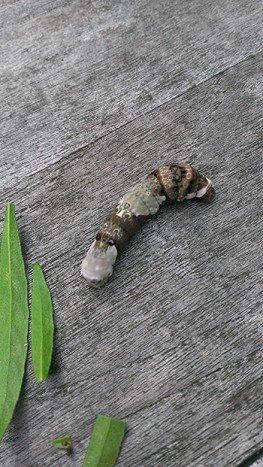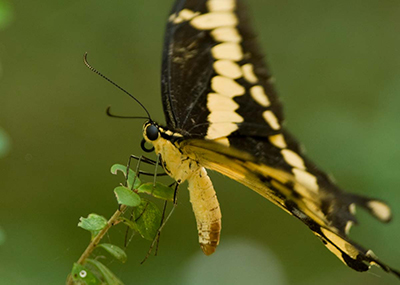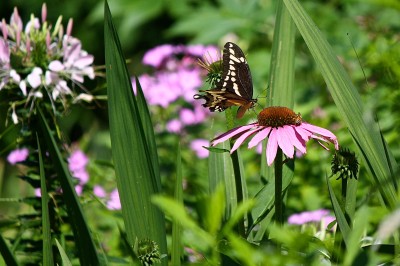The Bird Poop Caterpillar
 This cleverly disguised caterpillar was found munching in our gardens this fall. Papilo cresphontes, common name bird poop caterpillar, uses camouflage to resemble bird droppings. Younger instars often rest in plain view on the upper surfaces of leaves where you would expect to find bird droppings.
This cleverly disguised caterpillar was found munching in our gardens this fall. Papilo cresphontes, common name bird poop caterpillar, uses camouflage to resemble bird droppings. Younger instars often rest in plain view on the upper surfaces of leaves where you would expect to find bird droppings.
If the “poop” disguise doesn’t work , it can extend bright red osmeterium or hornlike appendages, to frighten away predators.

One of our largest butterflies, the Giant Swallowtail (Papilo cresphontes). photo credit: Amber Coakley-Birders Lounge
This unusual caterpillar is actually the larva of one of our largest butterflies, the Giant Swallowtail (Papilo cresphontes). It can have a wingspan of 4 to 6 inches, and is mostly black with yellow bands and some red and blue markings. The adult butterfly is a welcome visitor to pollinator gardens and to general landscape plantings.
Homeowners, however, may find that just a few larvae of the giant swallowtail can defoliate small, potted or planted citrus plants. Larvae should be handpicked from these small plants so that potential blossom and fruit yield are not drastically reduced. Fortunately, mature trees are large enough to withstand some defoliation.
The Giant Swallowtail is found mainly in deciduous forests in the east and citrus orchards in the south and west, where it is considered a major pest because of its habit of feeding on the foliage of most Citrus species. In these areas, it is also known as orange dog or orange puppy. Identified nectar sources include azalea, bougainvillea, Japanese honeysuckle, goldenrod, dame’s rocket, bouncing Bet, and swamp milkweed. These butterflies have also been known to sip liquid from manure.
In the Delaware Valley there can be two generations of Papilo cresphontes between May and August. They usually have a darty flight habit and can fly fairly high, making them difficult to notice, but the bird poop caterpillar can be found crawling in your garden.







Diane Mattis
Posted at 10:24h, 04 NovemberWow! An awesome Bird Poop Caterpillar. Mother Nature
never ceases to amaze me with her tricks!
Becky Robert
Posted at 10:45h, 04 NovemberI totally loved this trick too! It is the amazing the creatures you meet while gardening. Becky Robert
Nicole O'Neil
Posted at 11:44h, 04 NovemberI was pleased to see this post. We were disconcerted to discover these bird poop caterpillars on a potted orange in the patio of our home in Southern California. We’ve never seen or heard of them before and, until this post, didn’t know what they heck they were. Thank you!
Becky Robert
Posted at 13:53h, 04 NovemberGlad we were able to help you solve the mystery. It is amazing the critters a gardener finds.
Becky Robert
Scott Arboretum
Nancy Tedokon
Posted at 20:47h, 13 SeptemberVery amazing. I have never seen these before. We have a lot of them on our Satsuma Mikan tree, but they have not started munching yet.There are 2 older ones that are about 2 inches long on the trunk blending s well, you would think they were part of the trunk. Thanks for the article which identified them so quickly!
Becky Robert
Posted at 07:46h, 14 SeptemberDear Nancy,
I am glad we could help.
Happy Gardening,
Becky Robert
Scott Arboretum
L Welch
Posted at 18:23h, 11 JulyThank you! I couldn’t find this caterpillar’s identity anywhere else. (My blood orange tree thanks you as well!)
Becky Robert
Posted at 08:54h, 12 JulyGlad we could help L.
Good luck,
Becky Robert
Scott Arboretum
Jenelle
Posted at 21:34h, 29 AugustSo glad I found this! I relocated mine from my mini dwarf tangerine tree to my neighbor’s large orange tree! I hope to see them again once they’re butterflies!
Becky Robert
Posted at 08:53h, 03 SeptemberDear Jenelle,
We are excited about them too. Enjoy the butterflies!
Becky Robert
Scott Arboretum
James Carney
Posted at 11:48h, 17 SeptemberGood article. I found one this morning on my Myer Lemon in Wood County In easyt Texas
Becky Robert
Posted at 12:09h, 17 SeptemberThank you James. I hope you are enjoy the fall weather and creatures it brings.
Sincerely,
Becky Robert
Scott Arboretum
Nicole Brown
Posted at 22:23h, 11 JuneI saw one on my mom’s Meyer Lemon tree in Miami today. I was looking at the lemons and saw what I thought was a giant bird poop. Amazed to find out it was actually a caterpillar. Really cool!
Becky Robert
Posted at 08:28h, 12 JuneIt really is amazing the variety of “decorations” mother nature gives her creatures.
Happy Gardening,
Becky Robert
Scott Arboretum
Christine Celata
Posted at 23:37h, 20 JuneI found one on my young orange tree in Pasadena, CA. I have it in a jar with a leaf right now. If I let it go in the woods, am I starting a pest problem or helping a butterfly that I should be helping? Thank you.
Sabine Papallo
Posted at 14:28h, 09 JulyWe found several in our north florida property. We were so concerned after it ate an entire one of our small potted lemons
pat fletcher
Posted at 04:07h, 20 JulyMan! they eat our Lime and lemon trees down to the bone! Mean buggars and they stink when you smoosh them
Becky Robert
Posted at 07:49h, 20 JulySorry to hear they are taking a toll on your plants. It is always frustrating when the bugs “win”.
Happy Gardening,
Becky Robert
Scott Arboretum
Scott H.
Posted at 18:16h, 29 AugustJust found them on my Meyers Lemon tree. Relocated them to my dwarf mandarin orange tree since they don’t seem to like it. Weird looking creatures. I wonder if you collected them in a box and fed them citrus leaves, similar to silk worms, if you could get them to spin cocoons and transform into butterflies?
Jenn Opdahl
Posted at 19:45h, 10 SeptemberI also live in Southern California, and I had never seen these until this fall! This is very helpful. I don’t like the idea of killing them. If I want to remove them from my lime and lemon trees, what should I do with them?
Yvonne Negron
Posted at 00:29h, 31 OctoberOh, I am so sad. We started a garden during COVID and found grubs in our soil. Picked them out and put them in the bird box feeder. Then beautiful horny worms on our ghost pepper bush and tomato plants. And, now this evening picked 3 of these poop caterpillars off of our young lemon tree only to find out they turn into the majestic swallowtail butterflies. They did let off a stink, too! What’s the best way to get rid of them without killing them?
kathleen Forrest
Posted at 14:18h, 29 NovemberShould I move my caterpillar? The temperature is getting down to 30 this evening
Sherry Goetsch
Posted at 07:11h, 18 MayWow! I almost killed it but my husband wanted to research it out. I have a butterfly “house’ and would like to let the kids watch it grow into a butterfly. How could I accomplish that? Give the caterpillar lots of citrus leaves daily? We’ve raised painted ladies before, and have captured video of a monarch emerging from its chrysalis. God makes some amazing creatures. Thank you for sharing!
Vicki montage
Posted at 18:42h, 06 JulyWould they appear in Canada on a non citrus tree? I see many cocoons on my tree 6 Jul. there is not a citrus tree in site! Would it be any other caterpillar?
Patrick
Posted at 22:50h, 22 AugustWe are in Korea and saw the mother laying eggs on our potted lemon trees. At first my wife wanted to smash the eggs, but we decided to put them in a big container with some leaves and sticks in it, to see if they hatch. Indeed, they came out looking like little bird poops and are happily munching on the leaves we give them. It’s getting into early autumn now, so I guess they might stay put until spring rolls around again.
Do they cocoon and hibernate for the winter?
Barbara Higgason
Posted at 08:04h, 08 OctoberI live in Dallas and have a courtyard with numerous plants, one of which is a lime tree. I discovered what appeared to be bird poop on the leaves one morning.. It was a puzzle as there were numerous droppings and nothing above the plant to support birds. I brushed them off and found them again a few days later. As I found numerous leaves partially eaten, I assumed these were caterpillars. However, I have never seen the like before so decided to investigate. Ergo, I found your posting. And I thank you for it. I don’t want to harm them but I also have fought hard to keep that lime tree alive. I would love to seem transform but I’m not sure how to keep them alive until then and save my tree too. Suggestions?
Cindy Thomson
Posted at 19:28h, 07 DecemberI live in Mexico just south of Guadalajara and found the larva on my new lemon tree today. Thanks for the identification information.